Citation: Michelle de Medeiros Aires, Janine Treter, Antônio Nunes Filho, Igor Oliveira Nascimento, Alexandre José Macedo, Clodomiro Alves Júnior. Minimizing Pseudomonas aeruginosa adhesion to titanium surfaces by a plasma nitriding process[J]. AIMS Biophysics, 2017, 4(1): 19-32. doi: 10.3934/biophy.2017.1.19
The success of new biomaterials involves the understanding of what occurs at the cell/implant interface. The development of biomaterials with characteristics that enhance biocompatibility and reduce the occurrence of serious adverse effects such as implant rejection and infection is increasingly attracting the interest of the scientific community. Accordingly, processes that modify the composition, structure and morphology of the surface of the material and at the same time leave the mechanical properties of the bulk material intact are considered promising for the development of such new biomaterials.
Commercially pure titanium is widely used in dental implants while titanium alloys are employed principally in endosseous implants [1]. Several studies have demonstrated that titanium implants are biocompatible and capable of osseointegration. The biocompatibility between implant and the bone tissue leads to the formation of a protein layer on the implant surface under specified physiological conditions [2]. Therefore this phenomenon reveals the conflict between increased protein adsorption and inhibition of bacterial adhesion [3]. The surface of the implant through its interactions with proteins, bacteria and tissue cells plays a crucial role in the success of the implant [4], since implant failure are mainly due to lack of integration with the neighboring tissue or due to infections [4].
The adhesion of bacteria to the surface of the implant is considered the main cause of infections, as bacterial adhesion is the first stage in colonization and biofilm formation [5]. Biofilms, after adhering to a surface, begin to produce an exopolysaccharidic matrix which involves the bacteria [6], making it more resistant to antibiotics and to the host immune system [7]. It is estimated that 65-80% of nosocomial infections are associated with biofilm formation [8]. Normally, the occurrence of infections leads to the removal of implants, which not only imparts health problems to the individual patients, but also enhances costs within the public health system [9].
In order to reduce the risk of infection, prophylaxis is usually carried out by intravenous injection of an antibiotic before surgery. However high drugs concentrations in the blood for a long period of time can induce toxicity [10] and increase bacterial resistance to antibiotics [11].
The Gram-negative bacterium Pseudomonas aeruginosa is a major cause of infections associated with biomedical devices [12]. This is an opportunistic pathogen which colonizes human biotic and abiotic surfaces [13]. A study in the literature pointed out several important structures for adhesion and motility in biomedical devices [14].
In this sense, reduction bacterial adhesion may be a valuable strategy to prevent infections [2]. The control of surface composition by means of conventional plasma nitriding of titanium may be a promising approach to manipulate bacterial adhesion on biomedical implants [15].
Surface titanium nitride has shown a significant reduction of bacteria on the implant surface [16,17]. Plasma nitriding is a surface treatment technique which is commercially already established, mainly used for improvement of physical and mechanical properties of steels. The technique consists in introducing nitrogen into the material through a process activated by plasma [18]. In the last five years, this technique has led to the studies in which investigations of the biological properties of materials subjected to plasma nitriding were carried out [19].
In this work, titanium surfaces were nitrided by plasma and surface properties were correlated with bacterial response. The goal of the surface treatment was to minimize bacterial adhesion and subsequent biofilm formation.
Titanium disks were prepared from cp Ti (Grade Ⅱ) with dimensions 3 mm × 9 mm (diameter × thickness). Initially, the disks were metallographically prepared with silicon carbide sandpaper and polished with porous neoprene cloth (Pantec ®) impregnated with colloidal silica solution and hydrogen peroxide. The samples were afterwards washed with enzyme detergent followed by absolute ethanol and distilled water and submitted to ultrasound treatment for 10 minutes after each of that steps [20]. Samples of polished titanium disks were used as controls in each assay.
Surface modification of titanium disks was carried out in a cylindrical (300 mm × 300 mm) plasma-reactor made of stainless steel, equipped with a direct current power supply and a vacuum system as previously described [21,22]. Before plasma nitriding, a pre-cleaning step was performed as an attempt to remove oxides and another contaminants by using ionic bombardment with the following parameters: 2.0 sccm argon and 2.0 sccm hydrogen flow rates, 1.5 mbar pressure, 200 °C temperature and 448 volts of voltage, resulting in a current of 0,10 A. These conditions allowed plasma formation in which neutral species and charged ones, such as Ar1+, H1+ e H2+, were present. These species were allowed to clean the sample surface by sputtering and etching for 30 min.
For the plasma treatment itself, flow rates of 8 sccm hydrogen (H2) and 2 sccm nitrogen (N2) were employed. The working pressure was set at 2.2 mbar and the temperature during treatment was kept constant at 500 °C for 1 hour. After that, the equipment was turned off and the samples were allowed to cool down in the reactor chamber.
Diffraction measurements were carried out by using an X-ray grazing angle of 0.5° with the diffractometer (XRD) Shimadzu-6000, Cu Kα radiation at a 2θ scan from 33.0 to 45.0°. The PDF cards used as reference to identify the phases present were 44-1288 for Ti, 89-6975 for TiO2 and 87-0632 to the TiN acquired with the aid of JCPDS database. The diffraction peaks were decomposed with Gaussian functions using MagickPlot software.
The 2D and 3D nanotopography of the samples was observed using a Shimadzu SPM 9600 atomic force microscope (AFM). Four roughness parameters were thereby evaluated: average roughness (Ra), average maximum height of the profile (Rz), maximum profile peak height (Rp) and maximum profile valley depth (Rv). Photomicrographs were obtained in three different regions of each 2D and 3D sample. For each 2D micrograph, lines were obtained in order to determine the roughness profile.
Surface wettability measurements were also conducted. The sessile drop technique was used to characterize sample wettability [23]. The contact angle of distilled water droplets was measured on 6 disks of each surface type (nitrided and non-nitrided). Before the measurements, the samples were placed in a solution of 0.5% enzyme detergent in bidistilled water and submitted to ultrasound treatment for 10 min. After two washing procedures, the disks were washed with absolute ethanol, followed by bidistilled water. The contact angle measurements were performed by dropping 20 mL of either one the two investigated liquids: bidistilled water and glycerol as previously described [20,21]. Photographs were obtained at different times until complete drop relaxation, using Pinnacle Studio 9.0 image editing software. The results of wettability tests were obtained by using the free software free surftens, in which the contact angle between the solid surface (disk) and the tangential plane of the liquid surface (water or glycerol) is measured. The results for the contact angle for each surface were determined in this way [24].
The profile of N in nitrided samples was obtained with aid of Nuclear Reaction Analysis (NRA), using the reaction 15N (p, αγ) 12C. The NRA analysis was performed with the equipment single-ended accelerator (High Voltage Engineering Europe) 500 keV, the proton beam between 427-455 keV and 1 keV step, BGO detector (Bi4Ge3O12) located behind the sample aligned with the proton beam. The data obtained from the reaction 15N (p, αγ) 2C provides a curve of gamma radiation counts as a function of the energy of the proton beam. Using a standard sample, the counting of γ radiation was converted into atomic concentration of the isotope 15N which has natural abundance of 0.366%. This allows the calculation of the concentration of nitrogen (all isotopes) as a function of material depth.
Pseudomonas aeruginosa ATCC 27853 cells were aerobically grown at 37 °C for 24 hour on Mueller Hinton agar plates (OXOID, England). Several colonies were used to make the bacterial suspension in sterile sodium chloride 0.9% to achieve an optical density of 0.150 ± 0.003 at 600 nm (Spectramax M2e Multimode Microplate Reader, Molecular Devices, USA). P. aeruginosa biofilms were grown in 24-well plates containing a sterile titanium disk by using a technique adapted from [25]. After 6 hour of incubation at 37 °C, titanium samples were washed twice with sterile 0.9% sodium chloride and prepared to scanning electron microscopy. The sample was fixed in glutaraldehyde 2.5% followed by sodium cacodylate buffer 100 mM (pH 7.2) washing and treated with 2% osmium tetroxide. After that, a second washing process was carried out, in which the samples were dehydrated using increasing concentrations of acetone. After employing the CO2 critical point technique (CPD 030 Balzers, Liechtenstein) to remove all residual water, the metallization process utilizing gold was carried out in order to allow visualization at the JEOL JSM-6060 scanning electron microscope.
Results of Grazing Incidence X-ray Diffraction (GIXRD) are shown in Figure 1. Peaks were identified by Gaussian functions in order to separate phases present at the surface. The presence of TiO2 at the surface of the sample of untreated Ti (Figure 1a) is an indication of spontaneous oxidation that occurs when titanium is exposed to the environment. GIXRD analysis of samples nitrided for 1 hour and 3 hour (Figure 1b and 1c respectively) show broad peaks of TiN phase plans (111) and (200), which may be an indication of low crystallinity.
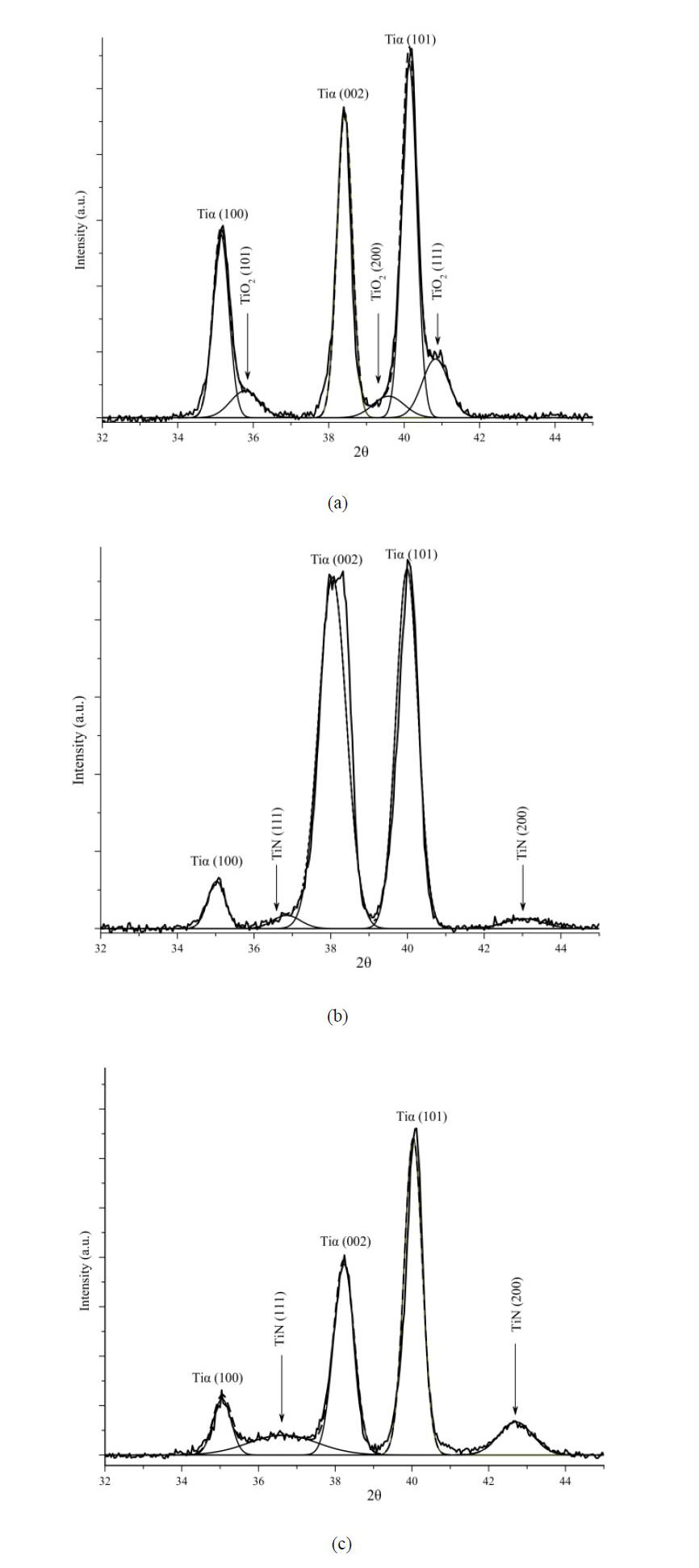 Figure 1. X-Ray diffratogram in GIXRD of titanium disks samples: (a) untreated (b) treated in 8H2-2N2 during 1 hour and (c) treated in 8H2-2N2 during 3 hour.
Figure 1. X-Ray diffratogram in GIXRD of titanium disks samples: (a) untreated (b) treated in 8H2-2N2 during 1 hour and (c) treated in 8H2-2N2 during 3 hour.As expected, the sample nitrided for 3 hours (Figure 1c) shows peaks with greater intensity than the sample nitrided for 1 hour. The increase in peak width of nitrided samples as compared to the untreated material may be attributed to a concentration gradient of nitrogen in titanium. It is known that nitrogen concentration decreases with increasing depth. This means that titanium lattice is more expanded at the surface than inside the material. That is, there is a distribution of diffraction intensity for each point which is penetrated by X-rays, reflected by peak broadening defects [26]. These are caused by the penetration of interstitial elements, which generates a non-uniform distribution of N in the network.
The existence of a concentration profile of nitrogen can be observed by analyzing NRA results (Figure 2). The sample treated for 3 hour has a maximum concentration of atomic nitrogen which is twice the maximum value for the sample treated for 1 hour. Nevertheless, the difference in nitrogen concentration for both samples is not so pronounced for greater depth values. This means that the process is controlled by the surface reaction.
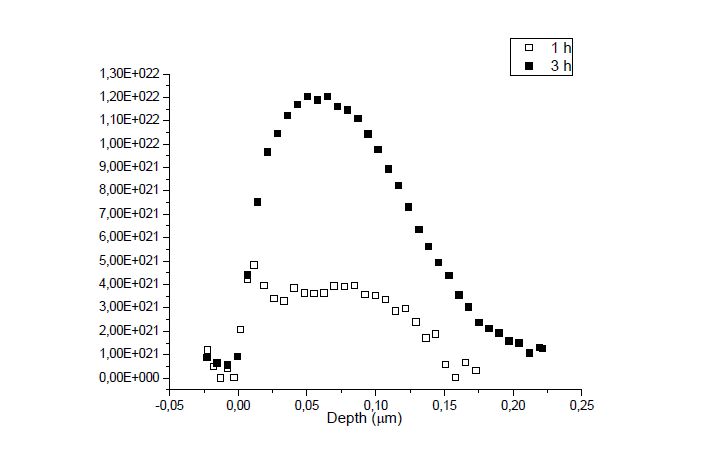 Figure 2. Concentration profile of nitrogen obtained by NRA on samples nitrided for 1 hour and 3 hour.
Figure 2. Concentration profile of nitrogen obtained by NRA on samples nitrided for 1 hour and 3 hour.The half-height width of the NRA curves indicates that the depth of the layer is about 150 nm and 250 nm for nitriding for 1 hour and 3 hour, respectively. The exposure time of the samples during nitriding did not influence the thickness of the layer but rather the amount of widespread N.
Regarding surface topography (Figure 3), nitrited surfaces are rougher than untreated ones. Roughness parameters Ra, Rz, Rp and Rv of the nanotopographies shown in Figure 3 are shown in Table 1 along with the value obtained for the contact angle by the sessile drop test with distilled water.
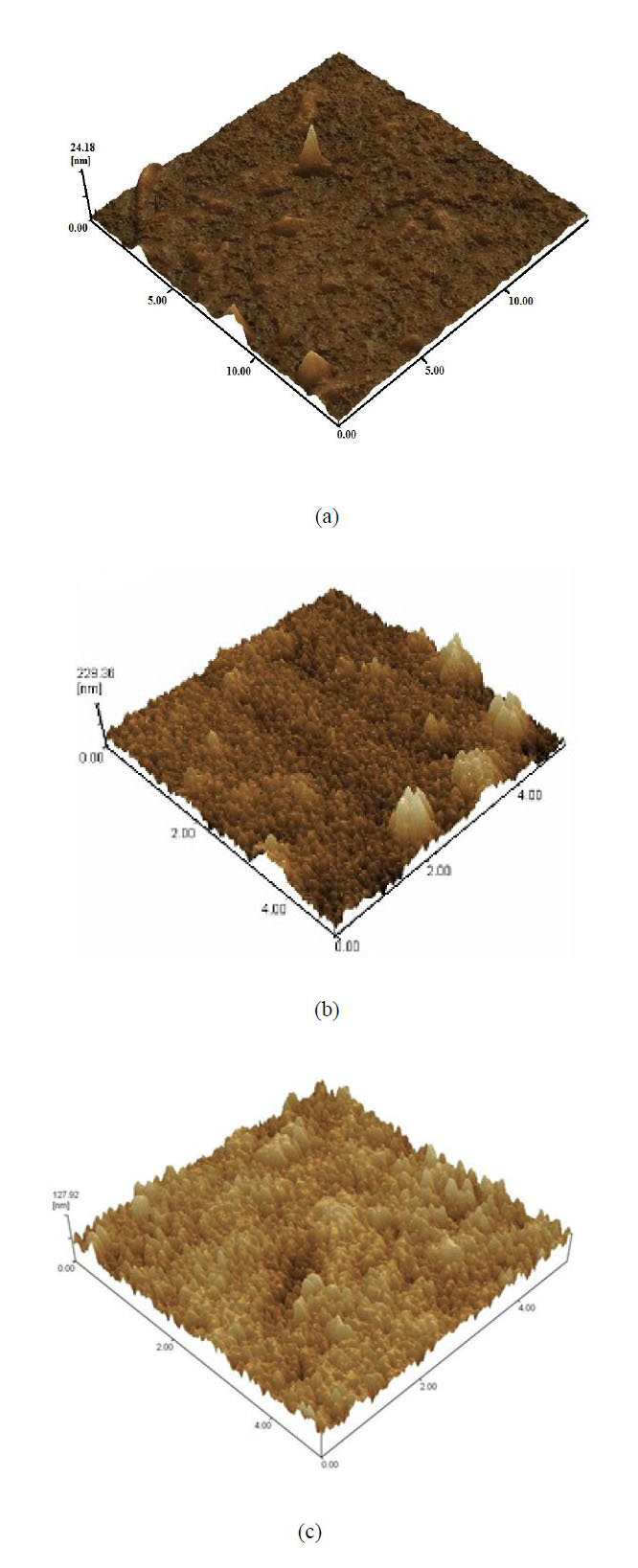 Figure 3. AFM topographies of titanium disks samples at the plasma conditions: (a) without treatment; (b) treated in 8H2-2N2 during 1 hour and (c) treated in 8H2-2N2 during 3 hour. Topographies profiles for scanning areas of 15 mm × 15 mm.
Figure 3. AFM topographies of titanium disks samples at the plasma conditions: (a) without treatment; (b) treated in 8H2-2N2 during 1 hour and (c) treated in 8H2-2N2 during 3 hour. Topographies profiles for scanning areas of 15 mm × 15 mm.The parameter Ra is defined as the mean peak and valley height on a surface [27]. An alteration in this parameter does not express all roughness variations, that is, alterations in the distribution and heights of peak may share common Ra values, not clearly defining surface relief behavior [28]. Several authors have correlated Ra values with surface wettability [27,28,29,30]. All these studies report a direct relationship between roughness (Ra) and wettability.
Another option for expressing topographic profile is the use of parameters Rp and Rz. The former is obtained by the mean peak height in relation to the midline in 5 consecutive readings and the latter is calculated from the sum of maximum peak height (Rp) and maximum valley depth (Rv), along the sample profile [31]. The Rp/Rz ratio is especially important for assessing surface format, since a ratio greater than 0.5 indicates sharp peaks, while values less than 0.5 indicate a surface with rounded peaks [31]. According to these authors, rounded peaks favor the scattering of liquids on the surface. Its influence on wettability can be estimated by using this hypothesis and assessing the Rp/Rz ratio. Wettability analysis is an important factor in defining biomaterial biocompatibility and this, in turn, is extremely important in biomaterial osseointegration [30]. Low contact angles means greater wettability, that is, a more hydrophilic surface [32].
The influence of topography and surface composition on bacterial adhesion is widely discussed in the literature.
Surface characteristics such as roughness can influence the amount and/or the conformation of the adsorbed proteins thus influencing bacterial adhesion and thus biofilm formation [2,33,34]. A surface with high roughness at the nano level shows increased surface energy, which leads to further adsorption of proteins [35]. Moreover, changes in chemical composition of the surface will affect the characteristics of protein adsorption.
In this work, as predicted in the literature, there is an inverse correlation between the parameter Ra and the contact angle. However, according to the obtained results, rounded peaks do not produce greater scattering of liquids, i.e., lower contact angle, as predicted in the literature [31]. It is observed that the surface with lowest value of Rp/Rz ratio (more rounded peaks) was not the one with the lowest value of contact angle. The sample nitrided for 3 hour, which has the lowest value of Rp/Rz ratio, the higher amount of TiN phase and the higher concentration of atomic nitrogen should result, according to the literature, in a greater wettability. However, this did not happen. From topographic chemical analysis, it was observed that only Ra had a direct correlation with wettability.
| Treatment conditions | Roughness parameters (nm) | Contact angle (Graus) | ||||
| Ra | Rz | Rp | Rv | Rp/Rz | θ | |
| Without treatment | 0,51 | 10,67 | 8,81 | 1,86 | 0,83 | 70,20 ± 4,00 |
| Nitrided (1 hour) | 21,00 | 269,00 | 186,00 | 83,00 | 0,69 | 45,00 ± 4,00 |
| Nitrided (3 hour) | 11,62 | 128,50 | 61,00 | 67,49 | 0,47 | 56,00 ± 3,00 |
A study by Xu and Siedlecki [36] on the influence of wettability in the adhesion strength of the proteins suggests that the value of the wettability can be a criterion for distinguishing adhesion proteins. It was also found by Truong, Rundell et al. [37] that bacteria S. aureus and P. aeruginosa had a tendency to adhere to hydrophobic titanium surfaces. Several authors have reported that hydrophilic materials are more resistant to bacterial adhesion than hydrophobic ones [38,39,40,41].
Figure 4 shows micrographs of titanium surfaces when exposed to culture of P. aeruginosa bacteria for 0.5 hour, 3 hour and 6 hour. It is observed that after 0.5 hour, the bacteria are attached in a dispersed manner then progressing to step clustering (usually when cell signaling begins) to finally form small bacterial clumps after 3 hour. It is clearly visible that the sample nitrided for 1 hour had higher adhesion strength.
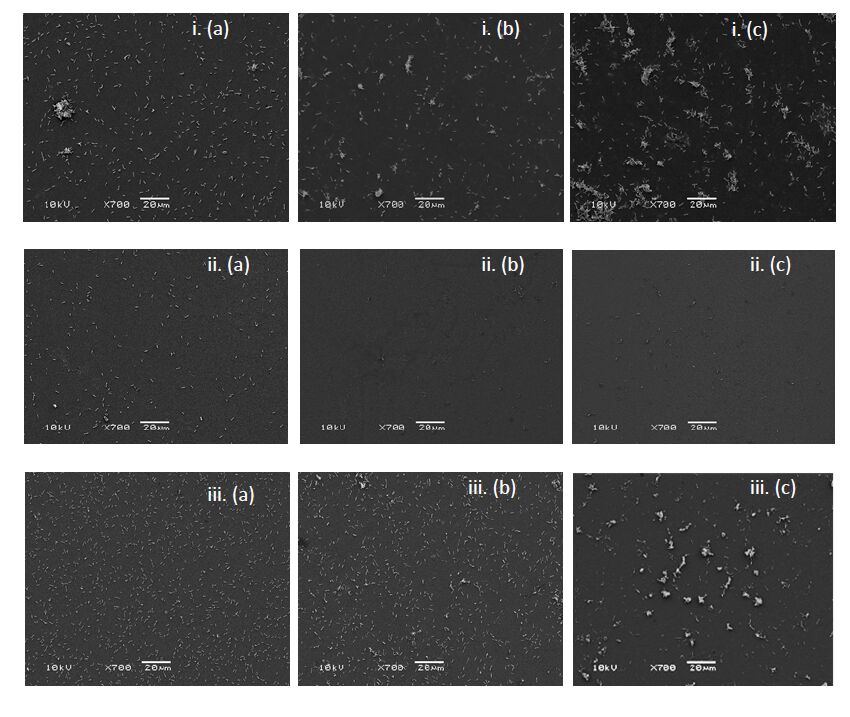 Figure 4. Pseudomonas attachment to i. Untreated disks, ii. Nitrided 1 hour disks, Nitrided 3 hour disks iii. surfaces at (a) 0.5 hour (b) 3 hour and (c) 6 hour.
Figure 4. Pseudomonas attachment to i. Untreated disks, ii. Nitrided 1 hour disks, Nitrided 3 hour disks iii. surfaces at (a) 0.5 hour (b) 3 hour and (c) 6 hour.Using an image processing software, it was possible to count the number of bacteria in each micrograph. Results suggest that bacteria count decreases with exposure time for all surfaces. This may be due to the occurrence of bacterial agglomeration (clumps), inhibiting the counting of individual bacteria, as the software recognizes a cluster of bacteria as one bacteria only. For the surface nitrided for 1 hour, the number of adherent cells is minimal and there was no formation of clumps or microcolonies. In addition to that, microbial growth did not occur and the bacteria dispersed without the presence of a chemical stress (such as antibiotic), which means that the environment formed after the thermochemical treatment of the surface is not conducive to the growth and development of a biofilm.
Since the formation of bacterial clumps is an essential step in biofilm formation [41], the count of these clumps is more representative in order to express bacterial proliferation than individual bacteria counts (Figure 6). Image analysis was performed and only microcolonies with a diameter greater than 46.23 µm were considered.
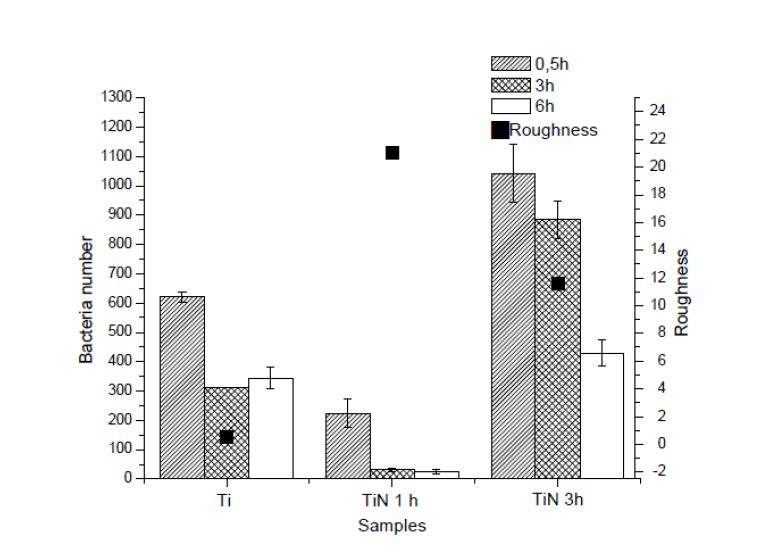 Figure 5. Number of bacterial adherent cells to untreated Ti and nitrided titanium (TiN 1 and 3 hour) disk. Correspondent roughness values are presented as black dots.
Figure 5. Number of bacterial adherent cells to untreated Ti and nitrided titanium (TiN 1 and 3 hour) disk. Correspondent roughness values are presented as black dots.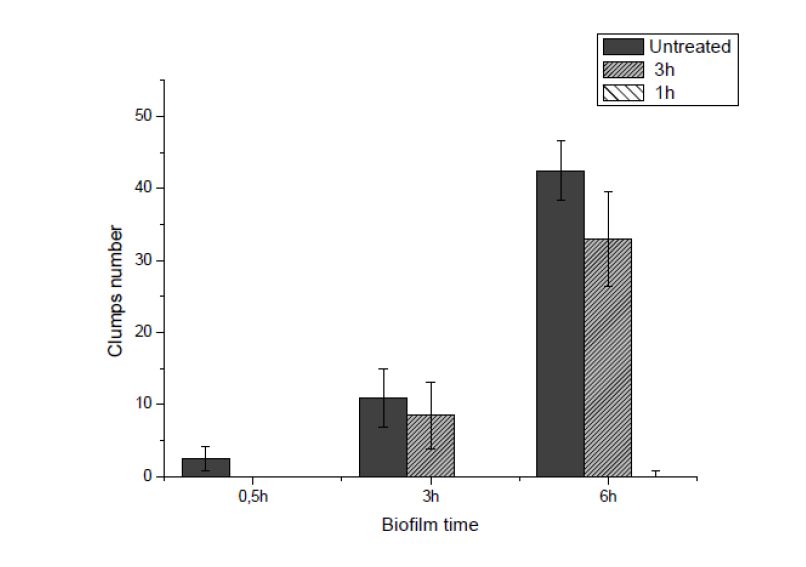 Figure 6. Number of lumps formed on the surface of titanium for different times of exposure to the culture P. aeruginosabacteria.
Figure 6. Number of lumps formed on the surface of titanium for different times of exposure to the culture P. aeruginosabacteria.Results show that the sample treated for 1 hour showed no formation of clumps during the six hours of analysis. The untreated sample showed the highest bacterial growth with the formation of agglomerates in this sample even for the time period of 0.5 hour. Results indicate that nitrided surfaces are more resistant to bacterial growth when compared to untreated titanium.
It is important to remember that the sample treated for 1 hour showed a greater Ra value than the one obtained for the sample nitrided for 3 hour and obviously a lower nitrogen concentration at the surface. Therefore, Ra is not a determining factor in bacterial adhesion and proliferation. On the other hand, the presence of TiN or titanium nitrogen atoms alone is not crucial to bacterial growth, since the sample nitrided for 3 hour had these conditions and results for this sample were worse than those of the sample nitrided for 1 hour. It is likely that the crystallinity and/or density of nitrides at the surface are a more important factor than those previously discussed.
As we pointed in the introduction biofilm formation is nowadays challenging physicians and hospital clinical staff, since it is hard to overcome and antibiotic therapy is not capable to destroy most of the biofilms. In this sense, is important to highlight that the performed treatments inhibited significantly the bacterial adhesion and consequently biofilm formation of one of the most known pathogen, Pseudomonas aeruginosa.
Ion nitriding thermochemical treatment for 1 hour proved itself ideal for the purpose of this study because the surface generated at these conditions showed no formation of microcolonies until the period of time of 6 hours of exposure to bacterial culture. It was found that this particular produced surface showed, in addition to increased biocompatibility, significant reduction of adherence of Pseudomonas aeruginosa, which prevents biofilm formation and offers lower risk of infection and extrusion.
All authors declare no conflicts of interest in this paper.
| [1] | Garg H, Bedi G, Garg A (2012) Implante surface m odifications: uma revisão. J Clin Diagn Res 6: 319–324. |
| [2] |
Zhao L, Chu PK, Zhang Y, et al. (2009) Antibacterial revestimentos sobre implantes de titânio. J Biomed Mater Res 91B: 470–480. doi: 10.1002/jbm.b.31463

|
| [3] | Hanawa TJ (2011) A comprehensive review of techniques for biofunctionalization of titanium. Periodontal Implant Sci 41: 263–272. |
| [4] |
Neoh KG, Hu X, Zheng D, et al. (2012) Balancing osteoblast functions and bacterial adhesion on functionalized titanium surfaces. Biomaterials 33: 2813–2822. doi: 10.1016/j.biomaterials.2012.01.018

|
| [5] | Hori K, Matsumoto S (2010) Bacterial adhesion: from mechanism to control biochemical. Eng J 48: 424–434. |
| [6] |
Hall-Stoodley L, Costerton JW, Stoodley P (2004) Bacterial biofilms: from the natural environment to infectious diseases. Nat Rev Micro 2: 95–108. doi: 10.1038/nrmicro821

|
| [7] |
Costerton JW, Stewart PS, Greenberg EP (1999) Bacterial biofilms: a common cause of persistent infections. Science 284: 1318–1322. doi: 10.1126/science.284.5418.1318

|
| [8] |
Coenye T, Nelis HJ (2010) In vitro and in vivo model systems to study microbial biofilm formation. J Microbiol Methods 83: 89–105. doi: 10.1016/j.mimet.2010.08.018

|
| [9] | Rosenthal VD (2008) Device-associated nosocomial infections in limited-resources countries: findings of the international nosocomial infection control consortium (INICC). Am J Infect Control 36: S171.e177–S171.e112. |
| [10] |
Chen Y, Zheng X, Xie Y, et al. (2010) Silver release from silver-containing hydroxyapatite coatings. Surf Coat Tech 205: 1892–1896. doi: 10.1016/j.surfcoat.2010.08.073

|
| [11] |
Breidenstein EBM, de la Fuente-Núñez C, Hancock REW (2011) Pseudomonas aeruginosa: all roads lead to resistance. Trends Microbiol 19: 419–426. doi: 10.1016/j.tim.2011.04.005

|
| [12] |
Campoccia D, Montanaro L, Arciola CR (2006) The significance of infection related to orthopedic devices and issues of antibiotic resistance. Biomaterials 27: 2331–2339. doi: 10.1016/j.biomaterials.2005.11.044

|
| [13] |
Kipnis E, Sawa T, Wiener-Kronish J (2006) Targeting mechanisms of Pseudomonas aeruginosa pathogenesis. Med Mal Infect 36: 78–91. doi: 10.1016/j.medmal.2005.10.007

|
| [14] | Lavoie EG, Wangdi T, Kazmierczak BI (2011) Innate immune responses to Pseudomonas aeruginosa infection. Microbes Infect 13: 1133–1145. |
| [15] |
Sarró MI, Moreno DA, Ranninger C, et al. (2006) Influence of gas nitriding of Ti6Al4V alloy at high temperature on the adhesion of Staphylococcus aureus. Surf Coat Tech 201: 2807–2812. doi: 10.1016/j.surfcoat.2006.05.023

|
| [16] | Scarano A, Piattelli M, Vrespa G, et al. (2003) Bacterial adhesion on titanium nitride-coated and uncoated implants: an in vivo human study. J Oral Implantol 29: 80–85. |
| [17] | Annunziata M, Oliva A, Basile MA, et al. (2011) The effects of titanium nitride-coating on the topographic and biological features of TPS implant surfaces. J Dent 39: 720–728. |
| [18] | Alves Junior C (2001) Nitretação a plasma: fundamentos e aplicações. Editora UFRN. |
| [19] | Aires MM, Oliveira RHA, Maribondo NKAG, et al. (2011) Análise da preferência celular em diferentes superfícies de Ti exposta ao mesmo meio de cultura. Revista Brasileira de Odontologia 68: 1. |
| [20] | Costa THC, Feitor MC, Alves Junior C, et al. (2008) Caracterização de filmes de poliéster modificados por plasma de O2 a baixa pressão. Matéria 13: 65–76. |
| [21] |
Sá JC, de Brito RA, Moura CE, et al. (2009) Influence of argon-ion bombardment of titanium surfaces on the cell behavior. Surf Coat Tech 203: 1765–1770. doi: 10.1016/j.surfcoat.2008.12.017

|
| [22] |
de Sousa RRM, de Araújo FO, Barbosa JCP, et al. (2008) Nitriding using cathodic cage technique of austenitic stainless steel AISI 316 with addition of CH4. Mat Sci EngA 487: 124–127. doi: 10.1016/j.msea.2007.10.001

|
| [23] | Öner D, McCarthy TJ (2000) Ultrahydrophobic surfaces. Effects of topography length scales on wettability. Langmuir 16: 7777–7782. |
| [24] |
Deshmukh R, Bhat N (2003) The mechanism of adhesion and printability of plasma processed PET films. Mater Res Innov 7: 283–290. doi: 10.1007/s10019-003-0265-z

|
| [25] |
Trentin DdS, Giordani RB, Zimmer KR, et al. (2011) Potential of medicinal plants from the Brazilian semi-arid region (Caatinga) against Staphylococcus epidermidis planktonic and biofilm lifestyles. J Ethnopharmacol 137: 327–335. doi: 10.1016/j.jep.2011.05.030

|
| [26] | Soltani-Farshi M, Baumann H, Rück D, et al. (1998) Content of hydrogen in boron-, carbon-, nitrogen-, oxygen-, fluorine- and neon-implanted titanium. Surf Coat Tech 103–104: 299–303. |
| [27] |
Elias CN, Oshida Y, Lima JHC, et al. (2008) Relationship between surface properties (roughness, wettability and morphology) of titanium and dental implant removal torque. J Mech Behav Biomed Mater 1: 234–242. doi: 10.1016/j.jmbbm.2007.12.002

|
| [28] |
Whitehead SA, Shearer AC, Watts DC, et al. (1995) Comparison of methods for measuring surface roughness of ceramic. J Oral Rehabil 22: 421–427. doi: 10.1111/j.1365-2842.1995.tb00795.x

|
| [29] | Lim YJ, Oshida Y (2001) Initial contact angle measurements on variously treated dental/medical titanium materials. Biomed Mater Eng 11: 325–341. |
| [30] | Albrektsson T, Wennerberg A (2004) Oral implant surfaces: part 2—review focusing on clinical knowledge of different surfaces. Int J Prosthodont 17: 544–564. |
| [31] |
Whitehead SA, Shearer AC, Watts DC, et al. (1999) Comparison of two stylus methods for measuring surface texture. Dent Mater 15: 79–86. doi: 10.1016/S0109-5641(99)00017-2

|
| [32] |
Kasemo B (2002) Biological surface science. Surf Sci 500: 656–677. doi: 10.1016/S0039-6028(01)01809-X

|
| [33] |
Deligianni DD, Katsala N, Ladas S, et al. (2001) Effect of surface roughness of the titanium alloy Ti-6Al-4V on human bone marrow cell response and on protein adsorption. Biomaterials 22: 1241–1251. doi: 10.1016/S0142-9612(00)00274-X

|
| [34] |
Michael KE, Vernekar VN, Keselowsky BG, et al. (2003) Adsorption-induced conformational changes in fibronectin due to interactions with well-defined surface chemistries. Langmuir 19: 8033–8040. doi: 10.1021/la034810a

|
| [35] |
Puckett SD, Taylor E, Raimondo T, et al. (2010) The relationship between the nanostructure of titanium surfaces and bacterial attachment. Biomaterials 31: 706–713. doi: 10.1016/j.biomaterials.2009.09.081

|
| [36] |
Xu LC, Siedlecki CA (2007) Effects of surface wettability and contact time on protein adhesion to biomaterial surfaces. Biomaterials 28: 3273–3283. doi: 10.1016/j.biomaterials.2007.03.032

|
| [37] |
Truong V, Rundell S, Lapovok R, et al. (2009) Effect of ultrafine-grained titanium surfaces on adhesion of bacteria. Appl Microbiol Biotechnol 83: 925–937. doi: 10.1007/s00253-009-1944-5

|
| [38] | Darouiche RO (2004) Treatment of infections associated with surgical implants. N Engl J Med 350: 1422–1429. |
| [39] |
Pascual A (2002) Pathogenesis of catheter-related infections: lessons for new designs. Clin Microbiol Infect 8: 256–264. doi: 10.1046/j.1469-0691.2002.00418.x

|
| [40] |
Pavithra D, Doble M (2008) Biofilm formation, bacterial adhesion and host response on polymeric implants—issues and prevention. Biomed Mater 3: 034003. doi: 10.1088/1748-6041/3/3/034003

|
| [41] | Treter J, Macedo AJ (2011) Catheters: a suitable surface for biofilm formation. Science against microbial pathogens: communicating current research and technological advances 2: 835–842. |
| 1. | M. Naeem, M. B. M. C. Felipe, S. R. B. Medeiros, T.H.C. Costa, M. S. Libório, C. Alves, R. M. Nascimento, I. O. Nascimento, R. R. M. Sousa, M. C. Feitor, Novel antibacterial silver coating on PET fabric assisted with hollow‐cathode glow discharge , 2020, 31, 1042-7147, 2896, 10.1002/pat.5017 | |
| 2. | Eugen A. Preoteasa, Elena S. Preoteasa, Ioana Suciu, Ruxandra N. Bartok, Atomic and nuclear surface analysis methods for dental materials: A review, 2018, 5, 2372-0484, 781, 10.3934/matersci.2018.4.781 | |
| 3. | Carlos Eduardo B. Moura, Moacir F. Queiroz Neto, Janine Karla F. S. Braz, Michelle de Medeiros Aires, Naisandra B. Silva Farias, Carlos Augusto G. Barboza, Geraldo B. Cavalcanti Júnior, Hugo Alexandre O. Rocha, Clodomiro Alves Junior, Effect of plasma‐nitrided titanium surfaces on the differentiation of pre‐osteoblastic cells, 2019, 43, 0160-564X, 764, 10.1111/aor.13438 | |
| 4. | Songmei Wu, Stefanie Altenried, Andi Zogg, Flavia Zuber, Katharina Maniura-Weber, Qun Ren, Role of the Surface Nanoscale Roughness of Stainless Steel on Bacterial Adhesion and Microcolony Formation, 2018, 3, 2470-1343, 6456, 10.1021/acsomega.8b00769 | |
| 5. | Gabriel Moura Martins, Janine Karla França da Silva Braz, Michelly Fernandes de Macedo, Jussier de Oliveira Vitoriano, Clodomiro Alves Júnior, Caio Sérgio Santos, Francisco Marlon Carneiro Feijó, Moacir Franco de Oliveira, Carlos Eduardo Bezerra de Moura, Enhancing Titanium Disk Performance through In-Pack Cold Atmospheric Plasma Treatment, 2024, 2373-9878, 10.1021/acsbiomaterials.3c01388 | |
| 6. | M.M. Aires, M. Naeem, R.F. Melo-Silveira, A.J. Macedo, I.V. de Souza, H.A.O. Rocha, R.R.M. de Sousa, C.Alves Júnior, A comparative investigation of plasma nitriding and oxy-nitriding treatment on cells and bacterial interaction on titanium surfaces, 2025, 339, 02540584, 130716, 10.1016/j.matchemphys.2025.130716 |
| Treatment conditions | Roughness parameters (nm) | Contact angle (Graus) | ||||
| Ra | Rz | Rp | Rv | Rp/Rz | θ | |
| Without treatment | 0,51 | 10,67 | 8,81 | 1,86 | 0,83 | 70,20 ± 4,00 |
| Nitrided (1 hour) | 21,00 | 269,00 | 186,00 | 83,00 | 0,69 | 45,00 ± 4,00 |
| Nitrided (3 hour) | 11,62 | 128,50 | 61,00 | 67,49 | 0,47 | 56,00 ± 3,00 |